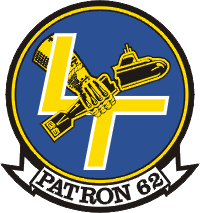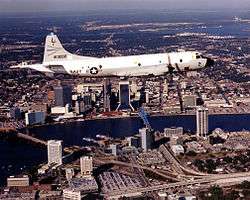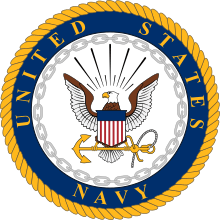VP-62 (1970-present)
VP-62 is a Patrol Squadron of the United States Navy Reserve. Since 31 July 2015, the squadron has been assigned to Commander, Maritime Support Wing, an Echelon IV organization under the Commander, Naval Air Force Reserve.[1]
| Patrol Squadron 62 | |
|---|---|
 VP-62 insignia | |
| Active | 1 November 1970 - present |
| Country | United States of America |
| Branch | |
| Type | squadron |
| Role | Maritime patrol |
| Aircraft flown | |
| Patrol | SP-2H P-3A/B/C |
Overview
The squadron was established on 1 November 1970. It is the fourth squadron to be designated VP-62, the first VP-62 having been disestablished on 1 July 1943, the second VP-62 having been redesignated VPB-62 on 1 October 1944 and the third VP-62 having been disestablished on 30 January 1950.[2]
Operational history
.jpg)

- 1 November 1970: VP-62 was established at NAS Jacksonville, Florida, under the operational control of Commander, Reserve Patrol Wing Atlantic, with a detachment at NAS Atlanta, Georgia.
- VP-62 was established from the personnel and SP-2H Neptune aircraft assets of VP-67F1 and VP-67F2 as a result of a major reorganization of the Naval Air Reserve that took place in 1970. The 12 Naval Reserve patrol squadrons formed were structured along the lines of Regular Navy patrol squadrons with nearly identical organization and manning levels. The concept, known as the 12/2/1 had 12 VP squadrons under two commands, Commander, Fleet Air Wings Atlantic and Commander, Fleet Air Wings Pacific, both under the control of one central authority, Commander, Naval Air Reserve.
- 1 July – 26 September 1971: VP-62 received its first P-3A Orion, completing transition training on 26 September.
- 1 April 1972: The Atlanta Detachment merged with the squadron at NAS Jacksonville, combining assets and personnel.
- November 1972: The squadron began receiving its first P-3A DIFAR-equipped aircraft as replacements for the older P-3A airframes. Transition was completed in late 1973.
- July – September 1975: For the first time, the mini-det concept was employed in squadron deployments. Rather than sending the entire squadron for one two-week period, small detachments of two and three aircraft were sent to NAF Lajes, Azores, extending over a period of several weeks.
- July 1976: VP-62 deployed to NAS Bermuda. Reserve crews obtained experience in provision of Anti-submarine warfare (ASW) coverage in the Atlantic theater of operation. For the first time, two reserve crews were selected to drop MK-46 torpedoes with practice warheads. Both crews scored direct hits on the target.
- 1977–8: Mini-dets deployed over a 24-month period to participate in Colombian Counter Insurgency exercises, a NATO exercise in the Azores, torpedo exercises in Puerto Rico, and Mediterranean exercises based at Naval Station Rota, Spain.
- February 1978: A VP-62 P-3A flown by a Squadron Augmentation Unit flight crew made a wheels-up landing at the Jacksonville International Airport. The resultant accident damaged the aircraft beyond economical repair, but the flight crew escaped without injuries.
- April–June 1978: Numerous mini-dets were deployed during this period, with VP-62 members serving shoulder to shoulder with their counterparts in the fleet operating from NAF Lajes and NAS Bermuda in tracking Soviet nuclear submarines.
- May – December 1979: VP-62 received its first P-3B replacement for the P-3A DIFAR aircraft. Transition was completed by December.
- 19 May 1980: VP-62 was called upon to provide support during the Cuban refugee resettlement operation. Crews flying out of NAS Key West, Florida, spotted refugees on the open ocean and directed their rescue by Navy and Coast Guard vessels.
- August 1981: VP-62 deployed to NAS Bermuda. During the two-week period of squadron operations, a record of four hurricanes in a row hit Bermuda. Nonetheless, the squadron participated in exercises Ocean Safari and Ocean Venture with no mission aborts.
- November 1982: VP-62 deployed for annual active duty training to NAS Bermuda, with periodic detachments at NAS Keflavik, Iceland; NS Roosevelt Roads, Puerto Rico; and NAF Lajes. During the deployment, it became the first reserve squadron to participate in drug interdiction flights in the Caribbean.
- October 1983: The squadron’s P-3B aircraft underwent refit to the TAC/NAV MOD updated airframe. The IRDS/HACLS modifications added infrared detection. The completion of these modifications gave squadron aircraft a Harpoon anti-ship missile capability. The last aircraft modification was completed on 31 March 1985.
- 1 April 1987: VP-62 aircrews commenced transition training to the P-3C Update III aircraft with training being done by the fleet replacement squadrons, VPs 30 and 31. First delivery of the new aircraft occurred in November 1987. The aircraft had an entirely new underwater acoustic monitoring system, doubling the number of Sonobuoys that could be monitored concurrently over earlier marks. Improvements in avionics, computers (AN/AYA-8) and cooling systems were added, along with a retractable forward-looking infrared turret under the chin and Harpoon missile capability. VP-62 completed transition to the P-3C UIII on 31 March 1989, marking the first time in reserve patrol aviation history that a reserve patrol squadron received the latest state-of-the-art maritime patrol and reconnaissance aircraft direct from the manufacturer (BuNo 163001 - 163005 and BuNo 163289 - 163291).
- 14 June 1988: VP-62 fired its first AGM-84 Harpoon missile during a live-fire fleet exercise. The missile was the first ever fired by a reserve aircrew from the P-3C UIII aircraft. It scored a direct hit sinking the target, a former Army Corps of Engineers barge.
- 15–30 July 1989: VP-62 became the first reserve squadron to deploy for active duty training to NS Rota with the P-3C UIII aircraft.
- May 1993: VP-62 became the first Navy patrol squadron to have a female assigned as a member of a combat aircrew. Lieutenant Commander Kay Hire, a naval flight officer who previously flew the RP-3A and RP-3D[3] and was an instructor navigator in the T-43A, was selected for duty with VP-62 as a P-3C UIII navigator/communicator. She later became a NASA Mission Specialist astronaut, flying missions STS-90 in 1998 and STS-130 in 2010.
- 1996: VP-62 is awarded the Noel Davis Trophy and the Battle Efficiency Award (Navy Battle "E").[4]
- 2006: VP-62 is awarded the Noel Davis Trophy and the Battle Efficiency Award (Navy Battle "E") for 2005.[5][6]
- 2007: VP-62 is awarded the Noel Davis Trophy and the Battle Efficiency Award (Navy Battle "E") for 2006.[7][8]
- 2008: VP-62 is awarded the Noel Davis Trophy and the Battle Efficiency Award (Navy Battle "E") for 2007.[9][10]
- 2009: VP-62 is awarded the Noel Davis Trophy and the Battle Efficiency Award (Navy Battle "E") for 2008. VP-62 was also awarded the 2008 Safety "S" for outstanding safety and Blue "M" for medical readiness.[11][12]
- 15 September 2009: VP-62 is awarded the Department of the Navy Safety Excellence Award.[13]
Aircraft assignments
The squadron was assigned the following aircraft, effective on the dates shown:[2]
Home port assignments
The squadron was assigned to these home ports, effective on the dates shown:[2]
- NAS Jacksonville, Florida - 1 November 1970
See also
References
This article incorporates text from the public domain Dictionary of American Naval Aviation Squadrons.
- OPNAVNOTE 5400 dated 9 July 2015
- Roberts, Michael D. (2000). Dictionary of American Naval Aviation Squadrons, Volume 2, Chapter 3 Patrol Squadron (VP) Histories (1st VP-62 to VP-90). Washington, D.C.: Naval Historical Center, Department of the Navy. pp. 326–8. Retrieved 23 June 2016.
- https://en.wikipedia.org/wiki/List_of_Lockheed_P-3_Orion_variants#RP-3D
- http://www.vpnavy.com/vp62_1990.html
- http://adserver1.harvestadsdepot.com/jaxairnews/ss/jaxairnews/ [10JUL2009]
- http://www.vpnavy.com/vp62_2000.html
- http://adserver1.harvestadsdepot.com/jaxairnews/ss/jaxairnews/ [10JUL2009]
- http://www.vpnavy.com/vp62_2000.html
- http://adserver1.harvestadsdepot.com/jaxairnews/ss/jaxairnews/ [10JUL2009]
- http://www.vpnavy.com/vp62_2000.html
- http://adserver1.harvestadsdepot.com/jaxairnews/ss/jaxairnews/ [10JUL2009]
- http://www.vpnavy.com/vp62_2000.html
- http://www.vpnavy.com/vp62_2000.html
